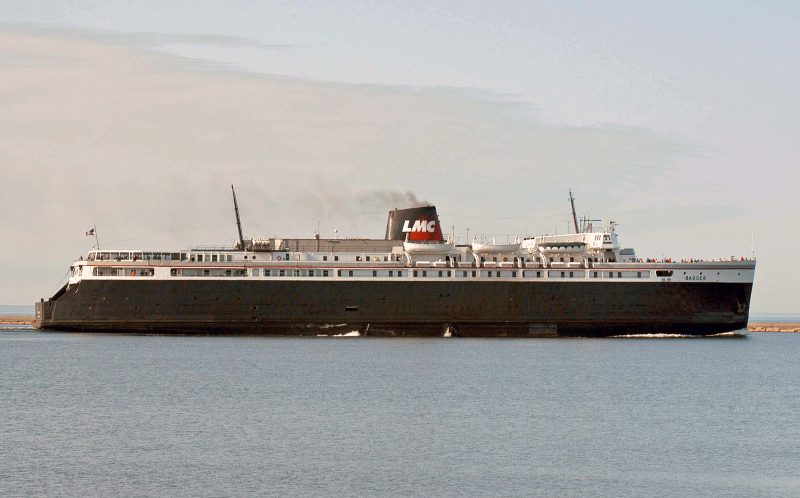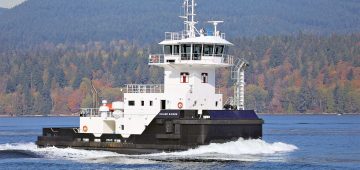A much loved Great Lakes Ferry lives on

On September 6th 1952, twin ships were christened at the Christy Corporation ship yard in Sturgeon Bay, Wisconsin. It was a business-like ploy by the new owners (the Chesapeake and Ohio Railway Company) to save a little money on commissioning costs, for only the S. S. Badger was launched that day, her sister, the S. S. Spartan had in fact been launched eight months earlier. Now only the Badger remains in operation and her survival and continuing success is truly a remarkable story. The S. S. Badger is the very last link to the days when the Great Lakes of America were criss-crossed by large ferries, specifically designed to carry not only railway engines and railcars, but also motor vehicles, a type of ship pioneered by American shipyards in the 1920s and subsequently replicated all over the world where the need occurred.
Badger and her sister-ship Spartan were delivered to their owners for operation across the Lake Michigan, linking Ludington, Michigan, to Milwaukee, Kewaunee, and Manitowoc, Wisconsin. The link from Ludington to Manitowoc was to prove particularly important, for it joined up not only a rail network, but also part of the highway network, known as US route 10. Built in 1926, this was one of the first long distance roads across the continent and it linked Detroit with Seattle on the Pacific Coast. Today, the current owners (the Lake Michigan Car Ferry Service) are proud to have her officially designated as part of US route 10, described as being ‘the continuance route’ by the United States Department of Highways and Transportation. The vessel now proudly displays the ‘US 10’ badge prominently on her stern cargo door, immediately above the vehicle ramp for all to see as they drive onboard.

Nowadays, this is just one of the accolades which have come her way. She is designated a ‘Mechanical Engineering Landmark’ by the American Society of Mechanical Engineers, and was placed on the National Register of Historical Places by the U S Department of the Interior in 2009. In addition, she was named ‘Ship of the Year’ by the Steamship Historical Society in 2002, and was most recently, on 22nd February 2016, declared a ‘National Historical Landmark’ by the National Park Service of America. It seems nearly superfluous to mention that ‘Trip Advisor’ also awarded her a ‘certificate of excellence’ for 2018!
Probably the most startling fact concerning the S. S. Badger is that she is the last seagoing vessel still operating commercially in the United States which is powered by coal fuelled steam engines. Her source of fuel is indeed nothing more than domestic coal, and the perseverance of her owners in that respect has been remarkable, when considering all the issues regarding the enforcement of legislation regarding ‘green’ energy on board ships. Given that ‘LMC’ recognised the uniqueness of the twin 3500HP ‘Skinner’ steeple compound unaflow steam engines and 4 ‘Foster Wheeler’ coal fired marine boilers, it is hardly surprising that her propulsion system is a large part of what makes the ship both unique and memorable. The historical plaque mounted on board the ship notes that the engines represent one of the last types of reciprocating marine steam built by the Skinner Engine Company and that most unaflow engines are single expansion. The Badger’s engines feature tandem high and low pressure cylinders separated by a common head, and the four type D marine boilers which supply 470 PSIG steam engines are amongst the last coal fired marine boilers ever built. Undoubtedly one factor which has made her survival not only possible but also financially feasible has been the original hull design and heavy scantlings. This is a ship built to withstand the rigours of many winters spent traversing the inhospitable and often ice laden waters of the Great Lakes. Strength-ened to ‘Ice Class’, and designed as an ice breaker, to this day the hull thickness of the steel is well within the required standards, a blessing not often accorded to ships in near continuous service for 63 years.
Subscribe today to read the full article!
Simply click below to subscribe and not only read the full article instantly, but gain unparalleled access to the specialist magazine for shipping enthusiasts.






Comments
Sorry, comments are closed for this item